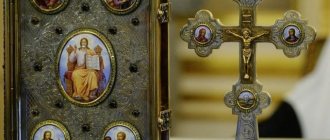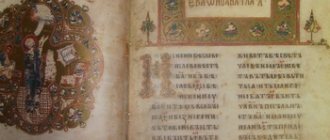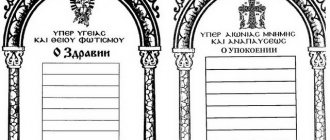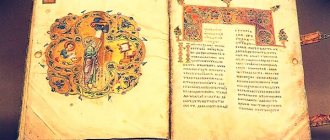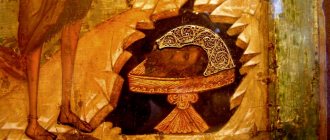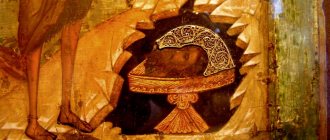The New Testament consists of 27 books. The most important of them are the Gospels, which describe the life and work of Jesus Christ. There are only 4 Gospels - Mark, Luke, Matthew and John.
In the beginning was the Word, and the Word was with God, and the Word was God.
With these words begins the fourth book of the New Testament - the Gospel of John.
The Gospels tell us about the life of Christ
The author of the Gospel is considered to be the Apostle John
The Church considers John the Theologian to be the author of the Gospel.
In modern science, there are 23 hypotheses about the authorship of the Gospel. The three most common are:
The author was the Apostle John Zebedee. He writes about himself in the Gospel:
Peter, turning, sees the disciple following him, whom Jesus loved and who at the supper, bowing to His chest, said: “Lord! who will betray you?
(John 21:20)
This disciple testifies to this and wrote this; and we know that his testimony is true
(John 21:24)
The Gospel had several authors who wrote from the words of an eyewitness. Members of the community, which is called the “John School”, possible disciples of the Apostle John, compiled the text of the Gospel from his words.
The author cannot be identified. “Beloved Disciple” is an allegorical insertion that was supposed to give the text authority.
Church tradition considers the author of the Gospel to be the Apostle John the Theologian.
Irenaeus of Lyons pointed out that the Apostle John wrote his Gospel in Ephesus in Asia.
Origen and Clement of Alexandria report that the Gospel of John was written after the others. Tertullian clearly indicates John as the author.
See also article 4 of the evangelist
From the Revelation of John the Theologian, church tradition took symbols for the evangelists. John received an eagle
When did the Gospel appear?
Do you think that when Christ lived on Earth among people, the Gospel already existed? No. More precisely, there was no Gospel as we are used to seeing it - there was no book that we could pick up, leaf through, and read. The living, incarnate Gospel was then Jesus Himself. He walked with his disciples around Palestine, preached, told parables, performed miracles, taught the apostles, and then died on the Cross, was resurrected and ascended to Heaven.
But after the Ascension, Jesus’ disciples were left without a Teacher. Probably, it was then that the first book appeared - the Gospel? Again - no. The book was not needed in the first years after the Ascension of Christ. Because everyone still remembered everything. There were many people in Palestine who saw and heard Jesus with their own eyes and even participated in the events of His life. They didn't need any records.
Years passed. There were more and more believers. Christian communities grew and arose outside of Palestine, in lands where other peoples lived. People recounted to each other what they had heard from the apostles. But you know how difficult it is to tell someone something word for word! Do you remember the game “broken phone”? One passes a phrase to another from memory, in his own words, and its meaning changes slightly. Then - a little more. And one more thing... Someone forgot something, thought it up, fantasized it in their own way. And someone deliberately changed the meaning. And now not a word remains from the initial phrase...
When it's just a game - okay, play and forget. And if the words you convey concern faith, the salvation of the soul, is it then possible to distort them? It is forbidden! Because people's lives depend on them. These words must be written down!
That is why the Gospels, compiled by Matthew, Mark, Luke and John, appeared in the form of books. Of course, they were not the only ones who attempted to write down the story of Jesus, but how are these evangelists different and why were only their works ultimately left in the Bible? In addition to the fact that the evangelists were part of the circle of Christ’s disciples during His earthly life, they also had the grace of the Holy Spirit - special gifts from God that allowed them to write the Gospels so that all the most important things were expressed correctly, without errors or distortions. If other people could get confused in the story about Jesus, retelling what they themselves did not see, then the evangelists “checked” with God all the time.
However, if you read their Gospels very carefully, you will notice that their stories about some events differ in some details! How so? But the whole point is that, possessing that same grace, each of the evangelists remained an absolutely free person, but all people see events a little differently. Just imagine that in the Gospels everything would be repeated exactly, even the smallest details. Then there would probably be a person who would say: they just conspired, they invented everything themselves and wrote it down like a carbon copy! And so it is clear that the Gospels are testimonies of living, but different people.
But here's another question. Why are there four Gospels, would one really not be enough? No, it wouldn't be enough. Firstly, it is all four books, complementing each other, that, to the necessary extent, tell us, today’s Christians, the most important thing about the life and teachings of Christ. And secondly, this is connected with when and how exactly each of the Gospels was created. After all, the apostles wrote their books at different times and for different people. Let's find out how it was!
John the Evangelist is considered the author of the Gospel, Revelation and Epistles
Little is known about the life of the Apostle John the Theologian. Together with his older brother Jacob, he was called by Christ.
Christ called the Zebedee brothers “sons of thunder” for their impetuosity of character
Together with the other apostles he accompanied Christ.
After the Crucifixion, he was given Asia Minor to preach.
Deacon
minister of the Christian church. The first seven deacons were appointed by the apostles
Until the Dormition of the Mother of God, John remained in Jerusalem, then, together with one of the seven deacons, Prokhor, he sailed to the city of Ephesus.
He got into a shipwreck, but was saved by the Lord.
He performed miracles in Ephesus, one of which was the destruction of the temple of Aphrodite. For this, John was exiled to the island of Patmos.
In exile on Patmos, John wrote Revelation
Emperor Nerva allowed John to return from exile.
The apostle returned to Ephesus and lived there until his death. In the last years of his life he wrote the Gospel.
John the Theologian
the only apostle who died a natural death
Holy Tradition claims that the Apostle John died at the age of over a hundred years.
The Gospel of John is preserved on the most ancient papyri
The Ryland Papyrus with verses from the Gospel of John contains the oldest fragment of the New Testament books.
Dating from early II, Epiphanius of Cyprus states that John wrote the Gospel when he was 90 years old.
Isidore of Seville provides similar data: he writes that John wrote the Gospel under Nerva, after returning to Ephesus.
John wrote the Gospel in Ephesus
In contrast, Theophylact of Bulgaria and Nikephoros Callistus report that the Gospel was written 32 and 36 years after the Crucifixion, i.e. in the 60s of the 1st century.
71
this year the Romans suppressed a revolt in Judea and destroyed Jerusalem
Euthymius Zigaben writes that the Gospel was written many years after the destruction of Jerusalem.
The most common view is the first: John wrote the gospel in the late 90s. I century
The Gospel of John reveals the theological ideas of Christianity
In its content and style, the Gospel of John differs from the rest of the Synoptic Gospels. Byzantine theologian of the 11th century. Evfimy Zigaben formulated this difference as follows:
Book by Efimy Zigaben Interpretation of the Gospel Buy on OZON.ru
When John received the Gospels of other evangelists from some believers and saw that they all spoke primarily about the incarnation of the Savior and omitted the teaching about His Divinity, he approved and allowed these Gospels and testified to their truth and authenticity.
Then, at the inspiration of Jesus Christ Himself, he began his Gospel; in it he tells something that has already been told by others,
so that they do not think that his Gospel has no connection with the Gospels of others, but he pays special attention to what they missed,
and most of all on the theological teaching about the Savior, as most necessary in view of the emergence of heresies.
Other evangelists missed this due to the imperfection of the listeners, since the sermon was not yet established,
and John also cites this teaching, since faith was already growing and the believers were becoming more understanding, adding other chapters omitted by the previous evangelists
John was nicknamed the Theologian for the spiritual height of the written Gospel.
The Gospel of John is loosely connected with the others in style and content
Common to all four Gospels is the description of the Passion of Christ.
The Gospel of John has the most similarities with the Gospel of Luke (Peter cutting off the guard's ear, the shroud in the tomb, Pilate's words about the innocence of Christ), and the least with the Gospels of Matthew and Mark (walking on water).
The Gospel of John outlines the spiritual ideas that the Church Fathers would later develop.
The Gospels of Mark, Luke and Matthew are called “synoptic” due to their similarity, from the Greek. "compound"
The Gospel has a number of features:
- the author uses the ancient concept of logos in relation to God;
- introduces the theme of Eternal Life;
- reveals the Divine Dignity of Christ;
- contains lengthy conversations of Christ with people (dialogues);
- includes episodes not found in the other Gospels;
- the most profound theologically.
Why does John not report such important events as the Nativity of the Savior or His Transfiguration?
Because he did not want to re-tell all the events associated with Christ, but only to complement the other evangelists, whose memories had already been written down by that time. John’s goal was to convey the most important thing that, for some reason, Matthew, Mark and Luke, who in biblical science are usually called “forecasters” (from the Greek Συνοπτικός - describing something together), were silent about. This is why the Gospel of John may seem almost thematically unrelated to the other three. There are only a few plot “intersections”: the feeding of five thousand people, the walk on the waters, the Last Supper, the denial of Peter, the trial by Pilate, the crucifixion - that, by and large, is all... And these events are described significantly differently than those of the “weather forecasters” .
For example, in the story about the Last Supper there are no words: Take, eat, this is My Body... This is My Blood of the New Testament, which is shed for many for the remission of sins (Matthew 26: 26, 28). But John remembers how Jesus Christ washed the disciples’ feet before the meal and commanded them to follow this example of love. And then he retells in detail the Savior’s farewell conversation with the apostles.
John’s goal was not just to tell how everything happened, but to emphasize the main thing: Jesus Christ is not just a Teacher, but the Son of God, equal in everything to God the Father.
“I and the Father are one ,” Jesus says to the Jews arguing with Him. – When you do not believe Me, believe My works, so that you may know and believe that the Father is in Me and I in Him (John 10: 30, 38).
One of the disciples, Philip, turns to Jesus with the words: Lord! Show us the Father, and that is enough for us , - and in response he hears: I have been with you for so long, and you do not know Me, Philip? He who has seen Me has seen the Father; how do you say, show us the Father? Do you not believe that I am in the Father and the Father in Me? The words that I speak to you, I do not speak from Myself; The Father who abides in Me, He does the works (John 14:6-11).
Concluding his conversation with his disciples, Christ offers a prayer to God: Glorify Me, Father, with You, with the glory that I had with You before the world was (John 17: 5).
He does not correct the Apostle Thomas, who, having become convinced of His resurrection, exclaims: My Lord and my God ! On the contrary, the Savior confirms his rightness: You believed because you saw Me; Blessed are those who have not seen and yet have believed (John 20:28, 29).
There are many similar passages in the Gospel of John.
The Gospel is divided into four parts
Theologians divide the Gospel of John into 4 semantic parts: Prologue (1:1-1:18), Book of Signs (1:19-12:50), Book of Glory (12:51-20:31), Epilogue (21)
Chapter 1 contains basic ideas about Christ:
In the beginning was the Word, and the Word was with God, and the Word was God...
(John 1:1)
And to those who received Him, to those who believed in His name, He gave the power to become children of God,
who were born neither of blood, nor of the will of the flesh, nor of the will of man, but of God.
And the Word became flesh and dwelt among us, full of grace and truth; and we saw His glory, glory as of the only begotten of the Father.
(John 1:12-14)
for the law was given through Moses; grace and truth came through Jesus Christ...
(John 1:17)
The Gospel echoes the book of Genesis:
In the beginning God created the heaven and the earth…
(Gen. 1:1)
The problem posed in the Prologue about who Christ really is runs like a thread through the Gospel. People who meet Christ try to understand who he is. Some people succeed.
Then the woman left her waterpot and went into the city, and said to the people, “Come, see a man, who told me all things that I have done: is not this the Christ?”
(John 4:28-29)
and some don't:
Many of the people believed in Him and said: when Christ comes, will He really do more signs than He has done?
The Pharisees heard such talk about Him among the people, and the Pharisees and the high priests sent servants to arrest Him.
(John 7:31-32)
The Book of Signs chronicles the adventures of Jesus
With In. 1:19 begins with descriptions of the adventures and miracles of Jesus. Chapter 2 describes his first miracle - the transformation of water into wine at a wedding in Cana of Galilee.
The expulsion of merchants from the temple is a popular plot described in Chapter 2
Chapter 3 and chapter 4 contain dialogues with Nicodemus and the Samaritan woman.
Dialogues of Christ with people are a distinctive feature of the Gospel of John
The dialogues in the Gospel are written to give readers a correct understanding of life. Jesus speaks about the Sacrament of Baptism - the new birth of a person for God:
...whoever is not born of water and the Spirit cannot enter the Kingdom of God...
(John 3:5)
...whoever drinks of the water that I will give him will never thirst; But the water that I will give him will become in him a fountain of water springing up into eternal life...
(John 4:14)
Chapter 6 contains the famous story of feeding the people with five loaves and two fish
Chapter 7 and Chapter 8 include Jesus' preaching and his rebuke of the Pharisees.
Chapter 9 - healing of the blind and dialogue. Another shame of the Pharisees:
...whether He is a sinner, I don’t know; I know one thing: I was blind, but now I see...
(John 9:25)
The meaning of the dialogue is that he who has seen the light of God should not return to the darkness of unbelief.
Chapter 11 talks about the resurrection of Lazarus
Notes
- “To most modern scholars direct apostolic authorship has therefore seemed unlikely.” "John, Gospel of." Cross, F.L., ed. The Oxford dictionary of the Christian church. New York: Oxford University Press. 2005
- [www.britannica.com/EBchecked/topic/304610/Gospel-According-to-John Gospel According to John
, Encyclopædia Britannica] - "John, Gospel of." Cross, F.L., ed. The Oxford dictionary of the Christian church. New York: Oxford University Press. 2005
- Merrill F. Unger, The New Unger's Bible Dictionary
, Chicago: Moody, 1988; p. 701 - ↑ 12
[www.reformed.org.ua/2/183/8/Guthrie D. Guthrie. Introduction to the New Testament. Gospel of John] - [azbyka.ru/otechnik/?Biblia/kommentarii-k-novomu-zavetu=4#sel= William Barkley “Commentary on the New Testament”]
- Bruce, F. F. The New Testament Documents: Are they Reliable?
p.7 - Eusebius of Caesarea, Ecclesiastical History, Book 3
- [www.bible-center.ru/book/interpretation/faith Bishop Kassian Bezobrazov, Interpretation of the Gospel of John]
- K. Rudolph. Gnosis: the Nature and History of Gnosticism. Harper, San Francisco, 1987, p. 305.
- ↑ 12
[azbyka.ru/otechnik/Lopuhin/tolkovaja_biblija_54 Explanatory Bible A.P. Lopukhin and successors]
The Book of Glory Contains Christ's Instructions
The Last Supper is the plot of chapter 13.
Chapter 14, like chapter 15, contains Christ’s instructions to his disciples and gives an understanding of the path to God:
I am the way and the truth and the life; no one comes to the Father except through Me...
(John 14:6)
He who does not love Me does not keep My words; But the word that you hear is not Mine, but the Father who sent Me...
(John 14:25)
Whoever does not abide in Me will be cast out like a branch and wither; and such branches are collected and thrown into the fire, and they burn...
(John 15:6)
Chapter 17 contains Jesus' prayer for the disciples, for their faithfulness and unity.
Chapter 19 describes the Passion of Christ and coincides with the other Gospels.
Chapter 20 talks about the Resurrection
The Gospel ends with simple and understandable words:
Jesus did many other things; but if we were to write about it in detail, then I think the world itself would not be able to contain the books written. Amen.
(John 21:25)
By leaving a comment, you accept the user agreement
Hegumen Bartholomew (Vasyukov) Distinctive features of the Gospel of John.
1. Introduction. What is the Gospel? Why are there 4 Gospels in the Church? 2. Main part. Purposes of writing the Gospel. Personalities of the Evangelists. Distinctive features of the Gospel of John. 3. Conclusion. Understanding the meaning of the Gospel is possible only in the Church of Christ.
“In the beginning was the Word, and the Word was with God, and the Word was God” (John 1:1) With these wondrous words of the first lines of his Gospel, the Apostle John forces those reading and listening to leave everything earthly and hear the Word of God. The Gospel of John is different from the three Gospels. My short essay is devoted to the study of these distinctive features. The divine men who lived before the law did not learn from scriptures and books, but having a pure mind, were enlightened by the illumination of the All-Holy Spirit, and thus knew the will of God from the conversation with them from God Himself “mouth to mouth.” Such was Noah, Abraham, Isaac, Jacob, Job, Moses. But when people became corrupted and became unworthy of enlightenment and teaching from the Holy Spirit, then the man-loving God gave Scripture, so that with its help they could remember the will of God. So Christ himself first personally talked with the apostles, and then sent them the grace of the Holy Spirit as teachers. But as the Lord foresaw that heresies would subsequently arise and our morals would deteriorate, He deigned that the Gospels should be written, so that we, having learned the truth from them, would not be carried away by heretical lies, and so that our morals would not completely deteriorate. The word “gospel” in the New Testament means the good news that Christ reconciled people with God and brought us the greatest benefits - mainly founded the kingdom of God on earth (Matthew 4:23), the teaching of the Lord Jesus Christ, preached by Himself and His apostles about Him as the King of this kingdom, the Messiah and the Son of God (2 Cor. 4:4), all New Testament or Christian teaching in general, especially the narrative about the most important events from the life of Christ (1 Cor. 15:1-4) , and then an explanation of the meaning of these events (Rom. 1:16). Being the message about what God has done for our salvation and good, the gospel at the same time calls people to repentance, faith and changing their sinful lives for a better one (Mark 1:15, Phil. 1:27). Finally, the expression “gospel” is sometimes used to designate the very process of preaching Christian teaching. In the Church of Christ the four Gospels are kept as precious treasures. “It is impossible for the Gospels to be more or less in number than there are, For since there are four countries of the world in which we live, and four main winds, and so the Church is scattered throughout the whole earth, and the pillar and foundation of the Church is the Gospel and the Spirit life, then it must have four pillars, spreading incorruption from everywhere and reviving people. From this it is clear that the Word, who organizes all things, sits on the Cherubim and contains all things, having revealed himself to men, gave us the Gospel in four forms, but permeated with one Spirit.” These words are spoken by Saint Irenaeus of Lyons (book 3 word 11, article 8). All four Gospels tell the same story about the life and teaching of Christ the Savior, about His miracles, suffering on the cross, death and burial, His glorious resurrection from the dead and ascension into heaven. Mutually complementing and explaining each other, they represent a single whole book that does not have any contradictions or disagreements among themselves in the most important and fundamental aspects. As Blessed Theophylact of Bulgaria reports, Matthew was the first to write the Gospel for the believing Jews eight years after the Ascension of Christ, Mark, the companion and disciple of the Apostle Peter, ten years later, Luke after fifteen, and the very last Gospel was written by the Apostle John after thirty-two years. .
Speaking about the distinctive features of the Gospel of John, I consider it necessary to briefly dwell on the purpose of writing the gospels and on the personalities of the holy evangelists themselves.
The holy evangelist Matthew was one of the twelve apostles, called by Christ the Savior himself. Having written his Gospel for the Jews, Saint Matthew sets as his main goal to prove to them that Jesus Christ is precisely the Messiah about whom the Old Testament prophets predicted, that the Old Testament revelation, obscured by the scribes and Pharisees, only becomes clear in Christianity and perceives its most perfect meaning. Therefore, he begins his Gospel with the genealogy of Jesus Christ, wanting to show the Jews His descent from David and Abraham, and makes a huge number of references to the Old Testament.
Evangelist Mark was not one of the twelve apostles, so he could not be a constant companion and listener of the Lord, as St. Matthew. He wrote his Gospel from the words and under the guidance of St. Apostle Peter. Clement of Alexandria claims that the Gospel of Mark is essentially a recording of the oral sermon of St. Peter, which St. Mark did at the request of Christians living in Rome. The very content of the gospel indicates that it is intended for pagan Christians.
The Gospel of Luke was clearly influenced by the influence of St. Paul, whose companion and collaborator was St. Luke. As the “Apostle of the Gentiles,” Saint Paul tried most of all to reveal the great truth that the Messiah - Christ came to earth not only for the Jews, but also for the pagans, and is the Savior of the whole world, of all people.
The beloved disciple of Christ John was a witness to the events and miracles performed by the Savior of the world in His earthly life: the first miracle of turning water into wine at a wedding in Cana of Galilee, the resurrection of Jairus’s daughter, the glorious transfiguration of the Lord on Tabor and others. He heard the Divine Teacher and he wrote down His word in the Holy Gospel and passed it on to us. Saint John Chrysostom says: “Let us listen not to the fisherman, not to the son of Zebedee, but to the one who knows the depths of God, that is, to the Spirit moving this lyre. He will not say anything human to us, but everything he says will be from the depths of the Spirit, from those secrets that even the angels did not know before they happened. And the angels, together with us, through the voice of John and through us, learned what we knew.” According to the Muratorian canon, John wrote his gospel at the request of the bishops of Asia Minor, who wanted to receive instruction from him in faith and piety. Clement of Alexandria adds to this that John himself noticed some incompleteness in the stories about Christ contained in the first three gospels, which speak only about the physical, that is, about external events in the life of Christ, and therefore he himself wrote a spiritual gospel. Eusebius of Caesarea, for his part, adds that John, having looked at and approved the first three gospels, still found in them insufficient information about the beginning of Christ’s activity. Blessed Jerome says that the reason for writing the gospel was the emergence of heresies that denied the coming of Christ in the flesh. The Holy Apostle John, when writing his gospel, on the one hand, wanted to fill the gaps that he noticed in the first three, with the goal of expounding more extensively and clearly the teaching about the Divinity of the Lord Jesus Christ, so that over time people would not begin to think of Him only as the “Son human”, and, on the other hand, gave believers weapons to fight the emerging heresies. As for the evangelist himself, he defines the purpose of his gospel as follows: “These are written so that you may believe that Jesus Christ is the Son of God, and believing you may have life in His name” (John 20:31). Saint Irenaeus of Lyons tells us: “This faith is proclaimed by John, a disciple of the Lord, and through the proclamation of the Gospel he intends to eliminate the error sown among the people by Cerinthus and even earlier by the so-called Nicolaitans, who are a branch of the falsely called knowledge (gnosis), in order to shame them and convince that there is One God, who created everything with His Word.” It is clear that the Apostle John wrote his Gospel in order to give Christians support for their faith in Christ precisely as the Son of God, because only with such faith can one achieve salvation, or, as John puts it, “have life in oneself.” The Gospel of John begins with an exposition of the doctrine of the Divinity of Christ and then contains a whole series of the most sublime speeches of the Lord, in which His Divine dignity and the deepest sacraments of faith are revealed, such as, for example, a conversation with Nicodemus about being born again by water and the spirit and about the sacrament of redemption ( John 3:1-21), a conversation with the Samaritan woman about living water and about worshiping God in spirit and truth (John 4:5-42), a conversation about the bread that came down from heaven (John 6:48-58) and about the sacrament of communion, a conversation about the good shepherd (John 10:11-18), and especially remarkable in its content is the farewell conversation with the disciples at the Last Supper with the final wondrous, so-called “high priestly prayer” of the Lord (John 17). Here we find a whole series of the Lord’s own testimonies about Himself as the Son of God. For his teaching about God the Word and for the revelation of all these deepest and most sublime truths and mysteries of our faith, the holy Apostle John received the title “Theologian.” A pure-hearted virgin, who completely, with all his soul, gave himself up to the Lord and was loved by Him with special love, Saint John penetrated deeply into the sublime mystery of Christian love. No one has revealed so fully, deeply and convincingly the Christian teaching about the two main commandments of the Law of God - about love for God and about love for neighbor, as John did in his Gospel and three Council Epistles. Therefore, he is also called the “apostle of love.” An important feature of John's Gospel is that while the first three Gospels mainly tell about the preaching of the Lord Jesus Christ in Galilee, Saint John sets out the events and speeches that took place in Judea. Thanks to this, we can see what the duration of the Lord’s public ministry was and at the same time the duration of His earthly life. Preaching mostly in Galilee, the Lord traveled to Jerusalem for all the major holidays. As can be seen from the Gospel of John, there were only three such trips to Jerusalem for the Easter holiday, and before the fourth Easter of His public ministry the Lord died on the cross. From this it follows that the public ministry of the Lord lasted about three and a half years, and He lived on earth for only thirty-three and a half years.
Concluding my brief narrative, I note that the first three gospels from Matthew, Mark and Luke are called synoptic by the Church (synoptics from Greek means looking together), because they depict the life of Christ in such a way that their three narratives can be viewed without much difficulty in one and connected into one cohesive story.
The Gospel of John in this regard stands apart, differing significantly from the first three both in the material presented and in the style and form of presentation. The Church calls the Gospel of John spiritual. Saint John concludes his story: “Jesus did many other things: but if we were to write about them in detail, then, I think, the world itself would not be able to contain the books that would be written. Amen" (John). Saint John Chrysostom speaks about this: “Since this evangelist said less than others, he says that all the others did not say everything, but as much as was necessary to attract those listening to faith. And if, he says, everything were described, then I think that the world would not contain books.” These words denounce sectarians who reject Holy Tradition and therefore distort Divine Revelation, which is preserved in the Orthodox Church. It behooves us to be faithful children of the Church, which is “the pillar and foundation of the truth” (Matthew 16:18).
1. Bible 2. New Testament. 3. Explanatory Bible 4. St. John Chrysostom 5. Blessed Theophylact 6. St. Irenaeus of Lyons 7. Towards knowledge of the Bible. About the Gospel
